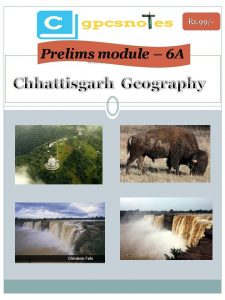Detailed Notes for Chhattisgarh Geography
Specifically designed Notes for Chhattisgarh Geography can be Bought at minimum price in PDF or Printed format
Faq’s on Geography of Chhattisgarh
Chhattisgarh is located in central India. It is bordered by Madhya Pradesh to thewest and northwest, Maharashtra to the southwest, Telangana to the south, Odisha to the southeast, Jharkhand to the northeast, and Uttar Pradesh to the north.
What are the major geographical divisions of Chhattisgarh?
Chhattisgarh can be divided into three major geographical divisions:
- The Northern Hills: This region comprises the Surguja, Jashpur, and Koriya districts, characterized by hills and plateaus.
- The Central Plains: This region includes the Raipur, Bilaspur, and Durg districts and is characterized by fertile plains.
- The Bastar Plateau: This region comprises the Bastar district, characterized by dense forests and hilly terrain.
Which is the highest point in Chhattisgarh?
The highest point in Chhattisgarh is Gaurlata, with an elevation of 1,225 meters (4,019 ft), located in the Surguja district.
What type of climate does Chhattisgarh have?
A: Chhattisgarh experiences a tropical wet and dry climate. Summers (March-June) are hot and dry, while winters (November-February) are mild and pleasant. The monsoon season (July-October) brings heavy rainfall.
What are the main rivers in Chhattisgarh?
2The main rivers in Chhattisgarh are:
- Mahanadi: The longest river in the state, originating in the Raipur district.
- Indravati: A tributary of the Godavari, flowing through the Bastar region.
- Hasdeo: A tributary of the Mahanadi, known for its coal reserves.
- Rihand: Forms the border between Chhattisgarh and Uttar Pradesh.
- Shivnath: A tributary of the Mahanadi, flowing through the Durg district.
What are the major natural resources found in Chhattisgarh?
Chhattisgarh is rich in natural resources, including:
- Minerals: Coal, iron ore, limestone, dolomite, bauxite, corundum.
- Forests: Teak, sal, bamboo, and other valuable timber species.
- Water resources: Rivers, reservoirs, and groundwater.
Are there any national parks or wildlife sanctuaries in Chhattisgarh?
Yes, Chhattisgarh is home to several national parks and wildlife sanctuaries, including:
- Indravati National Park: Known for its diverse wildlife, including tigers, leopards, wild buffaloes, and elephants.
- Kanger Valley National Park: Famous for its underground caves and waterfalls.
- Achanakmar Wildlife Sanctuary: Home to tigers, leopards, sloth bears, and various species of deer.
- Udanti Wildlife Sanctuary: Known for its wild buffalo population.
- Guru Ghasidas National Park: Named after Guru Ghasidas, a prominent social reformer of Chhattisgarh.
What are the major soil types found in Chhattisgarh?
The major soil types found in Chhattisgarh include:
- Red and Yellow Soil: Predominant in the hilly regions.
- Laterite Soil: Found in the Bastar plateau region.
- Alluvial Soil: Found in the river valleys, especially along the Mahanadi.
What is the importance of Chhattisgarh in terms of power generation?
Chhattisgarh is a major power-generating state in India due to its abundant coal reserves. The state has several thermal power plants that contribute significantly to the country’s electricity production.
